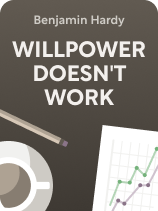

This article is an excerpt from the Shortform book guide to "Willpower Doesn't Work" by Benjamin Hardy. Shortform has the world's best summaries and analyses of books you should be reading.
Like this article? Sign up for a free trial here.
Is it hard for you to stay motivated and achieve your goals? Do you find yourself relying too heavily on willpower and discipline?
Forcing functions might be the solution you’re looking for. These self-imposed restrictions can help design an environment that naturally pushes you toward your objectives. By creating the right conditions, you can minimize the need for constant self-control.
Read on to discover how to harness the power of forcing functions in both your work and rest environments.
Forcing Functions
Hardy says that, ideally, your environment will force you toward your goals without the need for willpower and discipline. In a well-designed environment, you’ll accomplish your goals simply because you don’t have any other choice. Hardy says that you can do this using self-imposed restrictions called forcing functions.
(Shortform note: Hardy’s language here is a bit sensationalized, since it’s usually not possible to create situations where you literally have no choice besides working toward a goal. It would be more accurate to say that forcing functions force your attention to go where you want it to. In other words, setting appropriate restrictions or commitments for yourself doesn’t actually force you to take action, but it does force you to think about what you want to achieve and what the consequences will be if you don’t achieve it. This minimizes the need for willpower because you’ll be motivated by your hopes of accomplishing your goals and your fear of unpleasant consequences, instead of having to force yourself to do something just because.)
We’ll discuss how you can design your working and resting environments to force you to act in line with your goals, minimizing the need for willpower.
Force Yourself Toward Your Work Goals
Hardy says that, as you design your working environment, your first priority should be to create eustress. Eustress is healthy, manageable stress that keeps you focused and energized (as opposed to distress, which is distracting and tiring). You could also think of eustress as pressure or motivation; whichever term you prefer, it’s an external force that pushes you to do your best work.
Note that “work” in this context doesn’t just mean your job. Instead, Hardy suggests keeping eustress front-of-mind for anything that takes effort, such as fitness goals and creative projects.
Three Ways to Create Eustress
Hardy’s tips for creating eustress fall into three categories.
1. Challenging yourself. One of the most effective ways to create eustress is to set difficult goals because you’ll be motivated to work harder to reach those goals. This often means that the goal itself is ambitious, like doubling your income by the end of next year. However, it could also mean setting a goal that’s difficult for you personally, such as overcoming an injury or giving your house a top-to-bottom cleaning (if cleaning is something you struggle with).
2. Trying new things. New experiences are powerful motivators. This is because when you’re trying something for the first time, you’re forced to focus completely and work much harder than usual to make sure you’re doing it correctly. This principle also applies to learning new information: You have to stay engaged in order to understand and retain what you’ve learned. Therefore, whenever it’s feasible, take opportunities to experience new things—for example, you might take on a new responsibility at work, or find a podcast that teaches you about a topic you’re interested in. Note that this category of eustress will have some overlap with the first category (challenge) because it’s often difficult to do something you’ve never done before.
3. Creating consequences for failure. Challenging goals can be motivational, but they can also be disheartening. Therefore, to keep yourself on track, make sure that there will be consequences for you if you fall short. One way to do this is by investing your own resources into a project, meaning that you’ll suffer a loss if the project fails—for example, if you sign up for guitar lessons and then don’t go to them, you’ll have wasted your money. Another approach is to create social consequences by publicly announcing your goals to your friends and family, or anyone whose opinion you value. Since you won’t want to disappoint those people or be publicly embarrassed by failing at what you promised to do, you’ll work harder to reach your goals.
Force Yourself Toward Your Rest Goals
It might seem strange to set goals for your resting time, but remember that rest itself is the goal. Therefore, Hardy urges you to design every aspect of your resting environment with that goal in mind.
Whereas your work environment puts you under as much (healthy) stress as possible, your rest environment is a place where you’re protected from any stress. This should be a place where you can sleep, enjoy your hobbies, spend time with loved ones, and do whatever else makes you feel rested and refreshed—all without needing to worry about people putting demands on your time and energy.
First, Hardy says that you should decorate your environment in ways that help you to rest. For instance, choose colors and artworks that make you feel relaxed, uplifted, or joyful. Fill the space with things that make you happy such as books or collectibles, and get furniture that keeps you comfortable.
Second, writes Hardy, note that your rest environment isn’t just the physical space you rest in: It also includes the activities you do and the people you do them with. Therefore, joining social groups such as a book club or a fantasy football league can help keep you on track for your resting goals. Doing so will ensure that you regularly spend time with people who have similar interests and, in many cases, you’ll have a fixed schedule that forces you to do things you enjoy.
Rest Is as Important as Work
Effective rest is, naturally, crucial for recovering after working your hardest. However, Hardy adds that resting is also when your skills and abilities improve. The cycle of work and rest functions just like exercise does for your muscles: You go to the gym to break down your muscles, then they become stronger when they repair themselves. However, without a rest period, that process doesn’t work; if you kept working the same muscles every day they’d have no chance to repair themselves, so you’d never get stronger (and you’d probably injure yourself).
In addition, you’re more likely to have original ideas and creative insights while resting. This is because rest frees your mind to wander, so you can make connections between thoughts that you’ve never made before. Conversely, while you’re focused on work you’re only thinking about how to accomplish the task in front of you, which doesn’t give you much opportunity for creativity.
Finally, Hardy warns that most people simply don’t spend enough time resting, no matter how well they design their environments. He says that you should spend at least as much time resting as you spend working, and preferably more than that.
Occasionally Try a New Environment
Hardy also says that, no matter how well you’ve designed your resting environment, sometimes the most effective way to boost your motivation and creativity is to find an entirely new environment. By doing so, you can have what he calls peak experiences: rare, thrilling moments when you’re suddenly filled with energy and ideas.
The author adds that most people will have a few such moments in their lives simply by chance. However, you can experience them much more often if you deliberately seek them out. Furthermore, the strategy for doing so is fairly simple.
First, detach yourself from any outside stressors just as if you were going to your resting environment. Then, take a notebook and a pen and go someplace that’s not familiar to you. This doesn’t have to be anywhere distant or exotic; just a few miles from your home will do, as long as it’s a place you haven’t been before.
Hardy says that, once you’re there, take out your notebook and write down everything and everyone you’re grateful for in your life. This will help you to connect with what matters to you, and that connection will give you a powerful emotional boost.
Next, write down your current goals, both professional and personal. Are you hitting your targets or falling behind? What do you need to do to reach your goals? What changes do you need to make? What difficulties and frustrations are getting in your way? The purpose of this exercise is to clear your mind and refocus on your goals, so it’s crucial to be brutally honest with yourself—remember, nobody else will ever read this journal, so there’s no need to be embarrassed.
Finally, map out your grand dreams. What are your most ambitious hopes for the next few months, or the next year? What’s your ultimate life objective? The goal here is to reconnect with your core values and pinpoint the fundamental thing that motivates your actions. In other words, the goals you’ve set are your “what”; this last step is about finding your “why.” For instance, if one of your goals is to become a teacher, you might realize it’s because, at heart, you’re driven by a desire to help others or to make the world better for future generations.
Exercise
What’s one way you could modify your work environment to push yourself toward one of your goals? Remember that Hardy’s three main strategies for adding pressure with forcing functions are challenging goals, consequences for failure, and new experiences.

———End of Preview———
Like what you just read? Read the rest of the world's best book summary and analysis of Benjamin Hardy's "Willpower Doesn't Work" at Shortform.
Here's what you'll find in our full Willpower Doesn't Work summary:
- Why you can’t just “will” your way to success
- Practical ways to optimize your working and resting environments
- How you can make reaching your goals inevitable






